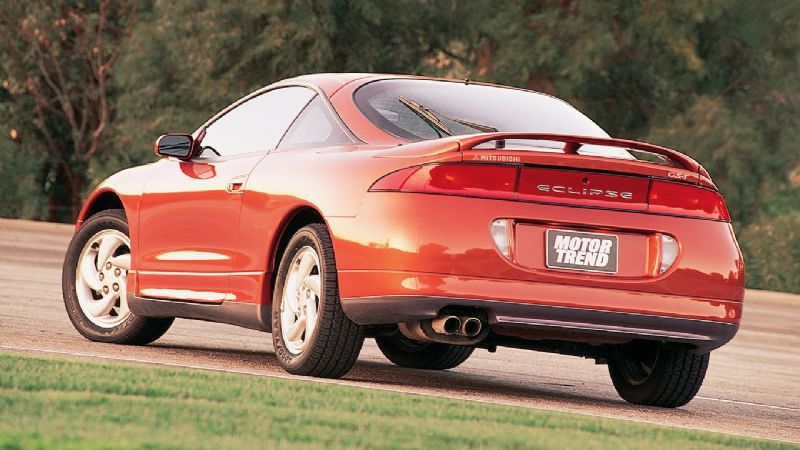Second Chances: 10 Vehicles Where the Sequel Topped the Original

In the movie business, it's rare that a sequel outawesomes the original, but that doesn't stop studios from trying (and trying and trying). Although retreads have become big business in the world of entertainment, few would argue there's anything other than diminishing returns to be found at the end of reboot road. The automotive world, though,turns this particular wisdom on its ear, as cars are redesigned and replaced all the time. And given that, there are more than a few examples of cars that didn't get it right the first time finding their footing in their second generationor vehicles that made the leap from good to great as they built on a strong foundation. Here are 10 of our favorite cars for which the second time was the charm: BMW 3 Series When the original E21-generation 3 Series went on sale in the mid-1970s, it was a significant leap forward for BMW compared to the smaller 2002 sedan . In many ways, it provided the perfect template for European automakers seeking to crack the international market and it also gave BMW the starting point for the vehicle that would be its passport to global recognition. When its E30 replacement arrived on the scene just under a decade later, it vastly expanded the entry-level car's engine range, provided more advanced technology, and delivered a luxurious experience that was a step above its predecessor.The E30 3 Series would become BMW's calling card and firmly cement its status among the nouveau riche yuppies of the go-go 80s, while simultaneously highlighting its motorsports achievements thanks to the now iconic M3 . Chevrolet Corvette The first-generation Chevrolet Corvette was initially a bit of a disappointment, what with its Blue Flame Six engine unable to deliver the thrills that its hot roadster bodywork promised. A hurried V-8 transplant would rectify that initial error, but it wasn't until the C2 Corvette appeared in 1963 that car would find itself on the road to becoming a legend.The second edition of the Corvette dramatically improved performance across the board, whether buyers stuck with its entry-level 327-cubic-inch V-8 or ponied up for a 427-cube big-block. It also introduced drop-dead gorgeous Sting Ray styling, with the split-window coupe and heart-stopping roadster cementing the Corvette in American pop culture forever. Dodge Viper The original Dodge Viper was rushed from concept to production in 1992 with barely enough time to breathe, let alone include expected amenities like side glass (a hanging plastic curtain did its best to keep the rain out) or door handles (you had to lean in and open the car from the inside). It was a brutal, raw beast of a machine aching for at least a little domestication in order to help it find a wider audience. The Viper's 1996 redux would answer all of the above issues by creating a car that wasn't just capable of protecting its occupants from the elements (and burglary), but also adding a big boost in horsepower and improved handing thanks to a revised V-10 engine and a tweaked chassis. It also introduced a hardtop coupe to sit alongside the roadster, meaningfully expanding its range of potential buyers, and it smoothed out the rougher edges of the first car's concept-heavy styling. The Gen 2 remains the most popular version of the Viper to this day. Toyota Supra When the Supra debuted on American shores in 1979, Toyota wasn't quite sure what it wanted its flagship coupe to be. As a result, the A50 Supra was a puzzling mix of long-hood sports-car styling riding on a stretched version of the lesser Celica platform, straddling the worlds of premium performance (of which it had little) and milquetoast personal luxury. The 1982 A60 Supra was an entirely different story. Although still wearing its Celica roots on its sleeve (and badge), this version of the car introduced an independent rear suspension, striking wedgelike looks, and a better power-to-plush ratio thanks to its lively straight-six engine and laudable grand-touring driving dynamics. This was the formula that would come to define the Supra. Dodge Ram The second Dodge on our list also featured a V-10 engine, although its impact to the company's bottom line extended far beyond its position in the horsepower wars. Despite Mopar's best efforts, the Ram pickup had been an also-ran for its decades-long existence, trailing the General Motors and Ford entries in the full-size sweepstakes. That all changed in the blink of an eye when the 1994 Dodge Ram burst onto the stage at the 1993 Detroit auto show. This is the truck that would introduce the big-rig styling that would go on to inform pickup design for the next 25 years, with its enormous grille and muscled bodywork standing in stark contrast to the more conservative Ford, Chevrolet , and GMC models of the time. Throw in the availability of a steel-block, Viper-family V-10 in the heavy-duty edition (alongside a Cummins diesel engine), and Dodge completely changed the game with its second-generation Ram. Cadillac CTS-V Cadillac had never built anything like the first-generation CTS-V, and it caught European automakers flat-footed when it was introduced as a 2004 model. Here was a Caddy sedan with a 400-hp V-8, a six-speed manual transmission, and a chassis that had been tuned at the Nrburgring, helping shatter preconceptions about the brand and raising its profile with an entirely new audience. As good as the original car was, it was significantly rawer than what most luxury buyers were used to. Enter the 2009 CTS-V , a vehicle that not only had a much more premium cabin and feature set, but also offered another 156 horsepower (thanks to a larger V-8 and a supercharger), the availability of an automatic transmission, and two additional body styles (coupe and wagon ). It was a major statement from Cadillac that brought the V badge to the mainstream. Toyota Prius The first-generation Toyota Prius was little more than a proof-of-concept, a car that was built to gauge the reaction from buyers to the idea of a fuel-sipping hybrid. As a result it was plain in design, limited in features, and when it eventually made it to America in the year 2000, not nearly as popular as it would later become. The model that changed the Prius' fortunes state-side was the 2003 redesign. Here was a hatchback that, if not attractive, was certainly distinct, and its longer wheelbase delivered a welcome boost in passenger room. It also provided a more highway-friendly driving experience to go with its startling fuel efficiency figures, and it wasn't long before the cult of the Prius began to coalesce. Dodge Charger There's really nothing wrong' with the original Dodge Charger . It was quick, offered big-block V8 power as an option (including a 426 Hemi), and presented as classier than the smaller and not-quite-as-quick Ford Mustang that had appeared a couple of years before its 1966 debut. Dodge would be quick to push the Charger to the next level, however, with the 1968 model. This is the car that launched a thousand Bullitts or is that Duke boys? and became the media face of badass muscle machines for the next 50 years. Nearly 100,000 examples were sold in the first year alone, and it would go one to dominate NASCAR as the winged Daytona in 1969. Mitsubishi Eclipse/Eagle Talon The DSM trio had gathered quite a following during their 19901994 production run, as tuners the world over flocked to the 1G's turbocharged four-cylinder engine and all-wheel-drive combo. Sold as the Mitsubishi Eclipse, the Eagle Talon, and the Plymouth Laser, these cars would deliver cheap speed in a slick package, provided you could stomach occasionally questionable reliability. When the platform was redesigned for 1995, Plymouth was jettisoned to make room for a much sleeker and more modern take on what a compact performance car would look like. In addition to introducing a convertible (Mitsubishi only), the mightier Eclipse and the Talon would double down on their turbo reign of terror and eventual earning a starring role in the Fast and Furious film franchise. Ford SVT Lightning Ford's mid-90s Lightning pickup was created in response to models like the Chevrolet 454 SS. Both took their respective manufacturer's largest available engine and stuffed it under the hood of a full-sized pickup that had been given light suspension tweaks, a bit of a body kit, and a sticker package. The Lightning was fun, but not earthshakingat least not until 1999, when round two emerged as the Ford SVT Lightning. Still based on the F-150 platform, this truck dropped its ride height, swapped in a supercharged 5.4-liter V-8, and went over-the-top with its stepside styling to present muscle-car fans with a legitimate quarter-mile threat to the established Mustang/Camaro leaders. A few years later it would gain even more power (peaking at around 380 horses and 450 lb-ft of torque), making it the most powerful pickup ever built until it was eclipsed by yet another Viper-powered Ramthe SRT-10in 2004 . The post Second Chances: 10 Vehicles Where the Sequel Topped the Original appeared first on MotorTrend .
http://www.motortrend.com/news/10-vehicles-sequel-better-than-original/




